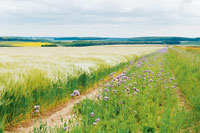Make the most of Higher Level Stewardship

Natural England has recently brought in a number of changes to the Higher Level Stewardship scheme, and farmers are queuing up to join. But with demand outstripping available funding, applicants must compete to secure an agreement. So what can they do to reach the top of the pile?
Initially, prospective applicants must check whether they are in a priority location, identified by Natural England as areas that should yield the greatest conservation results. Only farmers within these areas may apply. Each locality will have different priorities, such as biodiversity, landscape, heritage, and resource protection. Farmers within the target areas should contact Natural England for advice about which features and priorities are most relevant to their individual farm.
In an attempt to simplify the application process, Natural England is introducing a new three-tier system from 1 July, with a fast-track route for straightforward claims. In simple cases, Natural England will provide advice and prepare the Farm and Environment Plan (FEP) in-house, speeding up the turnaround time and reducing farmers’ up-front costs.
Standard or complex applications will continue to require an externally produced FEP, which looks at the key habitats and features on the farm. “Streamlining the HLS application process is timely because in 2011-12 Natural England calculates that more farmers will start HLS agreements than ever before, with as many as 2,400 applications, worth up to £40m, expected to start in the next financial year,” says Ian Fugler, director of land management. “This would be around 700 more than the previous high point of 2009/10.
“As HLS is a competitive scheme, it’s inevitable that some applications will be unsuccessful.”
Other changes have also been implemented, including reduced grants for farm building renovation and some types of educational access. “There will be a cap of £150,000 over a three-year period on the amount that can be spent on maintaining and restoring farm buildings, meaning that a larger number of smaller projects can be supported.”
Top tips |
|---|
Annual payments for educational access were temporarily withdrawn for new HLS agreements, following the spending review in November. However, they are now re-available, but will focus on visits by schoolchildren and vulnerable groups.
Another important change is a move to synchronised bi-annual payments, to be made every autumn and spring, instead of on the six-monthly anniversary of the agreement. This will apply to all agreements that started on or after 1 February 2007, and will be brought in from 30 June this year.
Jonathan Brunyee, associate director at Cumulus Consultants, says the key to a successful application is understanding and delivering against Natural England’s objectives in the local area. “With the new tiered application system you need to make sure you are linked into the local advisory team, whether that is directly with Natural England, or via consultants like us. Understanding what the targets are and how your farm fits in with those is crucial.”
The main priorities for many arable farms are likely to be farmland birds and resource protection. “HLS is discretionary and Natural England wants maximum environmental benefit with best value for money. I try to work out what’s best for the farm, both environmentally and financially, while balancing it with the conservation needs.”
“You need to understand which important species you have on the farm.” Nectar and wild bird cover could be sited near to hedgerows or watercourses and in awkward field corners, but skylark plots must be in open fields. “While payment rates may not be very attractive on better land when wheat is £180/t, take the long view. HLS is a 10-year agreement and, hence, offers a safe return.”
Protection of natural resources such as soil and water not only benefits the environment, but can also improve the farm’s agronomy and profitability, says Mr Brunyee. “Make sure you have a good range of options; don’t just choose the easiest ones. You need to make your application stand out in the pile, not just tick the boxes. And work with your agronomist to choose the best management for those options – over-wintered stubbles provide an early window for oilseed rape.”
Often, arable farms have areas of traditional wetland, ridge and furrow, orchard, hedgerows and pasture, which can be restored, he adds. “These little bits of habitat are crucial in an arable landscape so look at how you can link them together.”
However, Natural England is tightening up on capital grants, so where farmers want to restore traditional features they must justify it. “You need to explain how it will fit into the bigger picture.”
